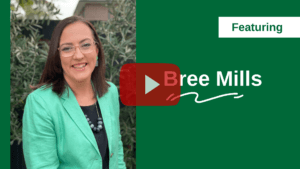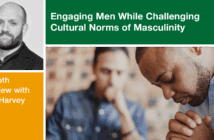
What are micro churches and how do they disciple missional leaders? In this episode, Bree Mills, director of Micro Churches Australia, shares the characteristics of micro churches, how they are formed, and how micro church leaders are developed.
Listen on Apple Podcasts | YouTube Music | Spotify
Read in-depth interview
Watch on YouTube

- Transcript — Click or Tap to Read
-
Announcer: Leading Ideas Talks is brought to you by the Lewis Center for Leadership of Wesley Theological Seminary in Washington, DC. Subscribe free to our weekly e-newsletter, Leading Ideas, at churchleadership.com/leadingideas.
Leading Ideas Talks is also brought to you by the Taking Church to the Community Video Tool Kit. Explore strategies your congregation can use to reach beyond its walls with worship, community events, ministries, and service. Learn more and watch introductory videos at churchleadership.com/shop.
What are micro churches and how do they disciple missional leaders? In this episode, Bree Mills, director of Micro Churches Australia shares with us the characteristics of micro churches, how they are formed, and how micro church leaders are developed.
Doug Powe: Welcome to Leading Ideas Talks, a podcast featuring thought leaders and innovative practitioners. I am Douglas Powe, the director of the Lewis Center and your host for this talk. Joining me is the founding director of the Micro Movements in Australia, Bree Mills.
Our focus for this podcast is micro churches. Bree, I’m so glad you’re joining us today and happy that you were willing to take this time. Can you, as you introduce yourself, share a little bit about yourself and denominational background before we get started into the micro church movement?
Bree Mills: Yeah, awesome. It’s great to be here. It’s really great to have a chat with you guys.
I’m from Melbourne in Australia and by training and background I’m an ordained Anglican minister in the Anglican Church of Australia, but I work predominantly now in a multidenominational kind of space. I’m married, I’ve got three teenage children, and we’re all still alive. So, that’s a good start. Yeah, it’s been a great journey with micro churches starting to move in Australia in this sort of direction. So, that’s just a bit of a background. I was a minister for about, gosh, 15 years, I think, in different capacities, and then I’ve moved more into this micro church space and training and resourcing others.
Doug Powe: Well, again, thank you for being with us. I’m going to start with the very obvious question. How do you define micro church — what is micro church?
Bree Mills: Yeah, sure. That’s a really good question and the answer is it depends; and it depends who you are and what you’re talking about. But for me, it’s all about that idea of having a small community of disciples that’s intentional about reaching out on mission to a particular people or place and demonstrating and proclaiming the gospel and making disciples in that sort of space. It’s really about that small, intentional community that to a degree has a missional identity, like they come together for the purpose of mission and discipleship. Whether that’s towards a network of people or a particular geographical place, that tends to be the most broadly accepted definition of a micro church.
Doug Powe: As you were talking, I was thinking. I’m Methodist and in the Wesleyan tradition, and we have sort of moved away from this. But at one time, we had small groups, and they were sort of missionally focused small groups. So, would you see micro churches as different? Or how would you make the distinction between the two?
Bree Mills: Yeah, well, it kind of depends on what your small groups are. A lot of small groups these days tend to focus on fellowship together or on times of worship and learning, but they’re not missionally driven. Usually, the biggest difference between a small group and a micro church is they don’t have that that sense of being sent together out on mission. Maybe, if it’s a good group, they’ll have a sense of individually going and doing that. But the goal of a micro church is to go together and focus on a particular people, group, or place together and generally to reach out. That’s one of the big differences.
I think the other difference is that the micro church is seen as church in itself and it’s a group of people who want to do life together and work together as opposed to people who just come together once a week. It’s a community. A lot of language is used around extended families. It’s a family on mission that does this work together and I think that is quite a difference from a typical small group.
Doug Powe: I appreciate what you said in the last part. A part of it, it sounds like, is there’s an intentionality around not just gathering on Sunday. You really think about: How do we structure our lives together for the whole week and live out our missional lives daily in whatever we’re doing or thinking about in terms of moving forward?
Bree Mills: Yeah, absolutely, and to do that together. I think otherwise we tend to spend a lot of our weeks on our own as believers in complete environments that are just not supportive. So, it gives you a sense of doing mission together with others and of having that integrated flock. There’s that old African proverb that says it takes a village to raise a child, and I think it takes a village to raise a disciple, too. So, it has that kind of village mentality to it.
Doug Powe: Great. Can you share how you got into this? Did you pilot a micro church at one time? Did you fall into it accidentally? How did you get into what is now called the micro church movement?
Bree Mills: Yeah, a mixture of “fell into it accidentally” and a really clear vision of God. This started actually for me when I was working in youth ministry. It came through an original youth ministry that we were trying in a small church, and we ended up reaching out to a whole lot of people that were never going to come into the church. We ended up with this group on the side doing other things. That was kind of our first foray into some other form of small church that was attached to or connected to an existing church.
Then I moved to a new church. I’d taken on a job as a youth minister, and I was actually in the process of praying about which job — I had a couple before me — to take and God just gave me a really clear vision, and it was a bit of an odd vision. I’m an Anglican minister, so this is not usual for Anglicans to receive kind of prophetic pictures and things like that. But it was a picture of these small square windows and actually some people I knew in this church kind of reaching their arms through this window and trying to pull people through it, and I’m like, they’re not going to fit. This was kind of a bit of a crazy picture. Then, straightaway, God showed me another picture of us standing at the corner of our church block and then walking down the middle of the street and just inviting people to come and join us. I didn’t get it at the time. Took me over six, almost 12, months to work out what God was saying. But it was just a really strong call for us to move outside our building and into our neighborhood, and when we started doing that, we had no idea — never heard the term micro church, missional communities, none of that. We were just being obedient to what we sensed God was calling us to do, which was to take a step outside our church building.
Doug Powe: And as you took that step out and you started doing this, I’ve read and heard where you talked about five characteristics that you have sort of pulled together that you think frame micro churches. Do you mind sharing those five characteristics with our audience?
Bree Mills: Yeah, hopefully we’re talking about the same ones, but yeah. For me, these are what we tend to call markers of micro churches. If you want to say, you know, “Is it a micro church?”, the answer has got to be yes, for me, to these five things. The first one is it’s got to be Jesus-centered. There are a lot of things that happen in life and in churches that I think don’t have Jesus at the center. Micro churches can’t be birthed out of anything other than God’s leading and guidance; and they have to be centered around the person and the work of Jesus. It sounds ridiculous and obvious but for us it’s really important.
Then, there are three other elements in terms of what does a micro church engage in, and for us that’s worship, community, and mission. Some people use language of up, in, and out around these. Our time with worship — that is not necessarily music but anything that we do that ascribes that worth to God. The time is a fellowship, and I think we’ve got to move away from that really simplistic idea of fellowship as, you know, a cup of coffee together after the service to something a bit deeper and are really those “one anothers” that scripture talks about and doing life at that deeper level as believers. And then mission and engaging in that mission together. They are the three elements that kind of sit at the center.
I’m unusual because I add a fifth one that most micro church practitioners don’t. I believe that micro churches have to be in partnership with the broader body of Christ. I actually don’t think any single church is called to be the Church on their own. We’re all called to be part of the one Church, and that means that we remain in relationship and in connection with others around us. Whether you partner with an existing church, whether you have a network of micro churches, whether you’ve just got a good relationship with the other three churches around you, whatever that might be, you can’t exist in isolation. I actually think it’s a biblical imperative that we can’t exist in isolation. So, they are the five things that I hold pretty tightly to. I think, when one of those is missing or something’s going wrong in one of those, you can see it and really, really clearly. That’s where issues start to form with some of these micro churches.
Doug Powe: We could spend the rest of time just around these five characteristics, but I have other things I want to get to. But I do want to do a couple of follow-up questions.
Bree Mills: Hmm, go for it.
Doug Powe: The first is how do you help to make sure these five become a part of the DNA or the fabric when a new micro church starts? Because I think the challenge is …. All churches would agree, hopefully, with the five characteristics you’ve outlined.
Bree Mills: I hope so.
Doug Powe: But the hard part is creating that DNA within a congregation. How do you build it in? Then the second part, which I think is just as hard, how do you maintain it? Once you build it in, as churches continue on and exist for a number of years, you start losing some of that. So, how can you create it and then how do you maintain it?
Bree Mills: Yeah, in our training and resourcing of the micro churches we’re connecting with, when someone comes to us and says they want to start a micro church, they’re based around these five characteristics. So, tell us why. What’s the vision behind it? Basically, we’re looking for that sense of God-directed and not “Well the pastor at my church is doing something I’m unhappy with so I’m going to go do this,” where we’re like, “Hang on. That doesn’t sound God-centered.” We’re going to tell you to go sort that out before you come back to us. I guess there’s a degree that at the starting point we’re checking and we’re asking questions that are around these five from the word go.
We’re also helping people to set up rhythms. When you think through the kind of worship, community, and mission, you can actually see that lived out in whatever rhythms of life you have as a community. If they’re saying to us, “We want to meet as a micro church. We’re going to meet on a Sunday morning. We’re going to read the Bible. We’re going to do this ….”, I’m going to be like, great, that’s excellent. That’ll give you times of worship, times of fellowship. Tell me about how you’re going to do times of mission. So, we actually structure it out.
In the micro church that I’m currently involved in (actually tonight), we run a board-game night at a local neighborhood house once a month, and we do lots of other things in the community. We’ve got a netball team. There are so many things that are kind of part of our rhythm of life together, and they’re not all, you know, intentionally evangelistic when they stand up there and present the gospel at those places. They’re just places that we’re engaging in our community and building relationships in that space. We’re really particular about actually building those things into your rhythms. And I think if you don’t build them into your rhythms, they get lost.
So I’ve seen lots of micro churches who have great intentions to do something in their community or to serve someone in their community but they spend most of their time just whistling through ideas. And they’re actually not getting to do something because they haven’t structured it into their gatherings, and they’re so busy with their other gatherings of just, you know, their Bible studies, their meeting for [prayer]triplets, or whatever it might be that they don’t leave any time in their calendar. So, it’s got to be structured into their rhythms of life.
Really the partnership is structured into their accountability, you know, who are you accountable to beyond yourself? You’re accountable to a network; you’re in accountability relationships with other pastors around you. To a degree, when you build it, all of this can be structured into that process. Then, depending on what metrics you use or what accountability mechanisms you use, it actually can be held in the same way — that we come back and ask every six months, how’s it going? What do your rhythms look like? We actually have a little tool where we talk about being Jesus-centered, about worship, community, mission. And we’re trying to get to the sweet spot in the middle, and we say draw your community for us. Are you like huge worship at the moment with a little bit of communion, a little mission? You can visually get people to map out where they think they’re at and therefore where they need to adjust. And so that’s one of the tools that we use to just help people keep their eye on all three and not just get moved in one direction.
Explore strategies your congregation can use to reach beyond its walls with worship, community events, ministries, and service. The Taking Church to the Community Tool Kit features engaging videos and presentations and is designed for both self-study and for use with groups in your church. Learn more and watch introductory videos now.
Doug Powe: I know your context is Australia, but I’m curious. Are you aware of micro churches within the United States? And do you have any connection or relationship with any of those churches?
Bree Mills: I do. There’s a lot of micro churches in the States and they’ve been a great blessing to us throughout our journey. I remember I connected with the Underground Church in Tampa back 2015. We were probably four or five years into what we were doing in Melbourne and suddenly a friend connected me to this underground church that wasn’t being public about what they were doing. And, yeah, we just found great relationship and friendship with those guys and a lot of similarities about what we were doing. But we’ve connected with lots of different groups over the years in in the U.S. There are the underground guys in the micro church space. There are a lot of guys in the missional community space and there’s some learnings from that we’ve found helpful and, even more recently, a couple of guys in the house church space, which are slightly different, but it has been interesting to talk with them and hear their stories and things like that as well. So, yeah, there’s heaps going on in the States. I spent some time with a guy who’s planted some micro churches through the Disney Parks.
Doug Powe: Interesting.
Bree Mills: Which is really, really, really exciting to hear his story. He’s doing some great work training others through that space, but really exciting.
Doug Powe: The next thing I want to talk about is leadership. You’re ordained Anglican, but I’m curious. If I came to you and I was not ordained, would I be allowed to start a micro church? Do I have to be ordained? What is there in terms of helping people discern their role, in terms of leadership of micro churches …
Bree Mills: Yeah.
Doug Powe: … that you help people think through?
Bree Mills: Yeah, I’d almost prefer you weren’t ordained to be totally honest. And that’s not because I have anything against ordination but because, if you see a micro church planted by an ordained person, everyone else thinks they have to be ordained to plant one. And that’s not the case. This is a lay-led kind of movement. We equip anybody really who’s a follower of Jesus who wants to continue to grow in their relationship with him and to step out on mission. We will equip anyone to lead a micro church irrespective of whether you’re ordained, not ordained. A lot of people who lead micro churches, especially in Australia, have full-time jobs in corporate, in other spaces. This is not a big heavy job they get paid for. This is something they do off the side and around what they’re already doing. No, you definitely don’t need to be ordained.
There’s still a lot of training that we encourage people to do as micro church leaders.
There’s a lot of, I think, responsibility in taking on the pastoral leadership of a micro church. But that’s also why I think it’s really healthy to be in partnership with others in a network or in partnership with the local church. It’s great to have an ordained person around and kind of overseeing the network or, you know, just being a point of support and encouragement and resourcing because sometimes in these micro churches you can run into some really challenging stuff to deal with. Having that sort of connection to the broader body of Christ means you can bring in people who have particular resources to be able to deal with those situations in a way that, you know, an everyday lay person may not have those resources.
Doug Powe: You talked about training. Do you all have a training program? Again, if I came to you and said “I believe God has called me to this ministry,” would you then set me up with a training program before I started? How would that work for someone who was lay to begin this work?
Bree Mills: We have some training that we do as part of our network, which is Sent Collective, which is a church-planting network in Melbourne. And Micro Movements has some other trainings that they do. But Micro Movements, the organization that I lead, is a collaborative of a whole lot of micro churches and networks from around Australia. They all have their own slightly different training, but we collaborate and share between us. Much like what’s going on in the U.S., there’s lots of people out there who will train you in micro churches. They’re all slightly different and they all have their different values. But, yes, if you want to say “Hey, I want to be a micro church leader,” we would say, “Great! Let’s do some training and coaching.”
I actually think coaching is even more important than training because I think that allows you to kind of tackle character and stuff with a leader, and it’s not just about giving them the information so that they can then lead a micro church and to know how to do the right things, but it’s to make sure that their character is one that actually demonstrates Christ to their community and their micro church and to help them hold accountability in that. We are really big on coaching, so every month the church leader needs to have a coach. Certainly, in my network, but across Australia, that’s pretty much the standard approach for many.
Doug Powe: Then for those individuals, is the expectation that it wouldn’t be the sole responsibility of this one person to carry the day? I’m assuming the hope is that the community as a whole is going to take responsibility and you’re going to have different roles even though this individual is sort of “the leader.”
Bree Mills: Well, we actually usually talk about it as a core team. We basically won’t let you plant unless you’ve got a core team, so usually it’s one person who’s the — we use the language of — key leader. They’re the one who comes to us and says, “Hey, I’ve got a heart for, you know, women struggling with homelessness in the city.” Like, great. There’s your heart, there’s your missional identity. Then we say, great, go and chat to some people, see if there’s others who come alongside you who are interested in doing that, too, and form a core team. In that core team, we’re looking for a good mix of gifts, different skills and training and resourcing. The core team is what leads the community, not that key leader. The key leader holds the vision for the community. And often they’re the one who we will coach so that they can keep that vision centric in the community. But, yeah, we really are strong on that team-based leadership because, especially if you’re holding that full-time job, you can’t take this on if you’re doing everything. It’s got to be a team approach.
Doug Powe: Yeah, that makes sense. Now I’m sure you’ve had this question often. Let’s say that things just go wonderfully well and my micro church all of a sudden has 100 people or 150 people. Is there a point in time where you’re no longer a micro church? You’re actually too big. How do you handle that situation?
Bree Mills: Yes. That’s a great problem to have. That would make you, at 150, probably bigger than the majority of Australian churches, non-micro church churches. Our heart is to see multiplication, so we like to see churches kind of multiplying wider than growing higher, if that makes sense. We really want to see churches multiply. In Australia we found that if you hit about forty, you really need to start moving towards multiplication. We’ve had one in our house that included kids that was over fifty, and it was a bit crazy. Thankfully, at that time we had one big kind of rumpus room that worked for it. But that’s about as big as I would see them grow in Australia.
I’d be really keen to multiply them, once they start getting over 35, to move in that direction. We’ve seen different things in Australia. Often, they multiply. You know, there’s different visions that arise as you see people come to faith and they have a sense of people they’re called towards. You kind of cultivate those visions and send them off. We have seen a couple of micro churches become congregations of a normal church, which has been really interesting.
Doug Powe: Wow, interesting.
Bree Mills: We planted them as micro churches, but in both cases they were ethnic micro churches, reaching a particular ethnic population. Because of the kind of cultural context of that ethnic congregation, they were often looking for high places to worship, basically. They’d reach their friends, they’d bring their friends, and they didn’t want to be small. Just culturally, they wanted to get together with everyone, so they became congregations. Great. That’s an excellent kingdom outcome.
I’m not particular on “the model is the only way to go.” It’s really a starting point, and I’m hoping that is something that either multiplies out or it can grow into a church, grow into just a congregation of the Church. I think it can do any of the above. If I had a lot of control over church planting, I’d be encouraging every church planter to start with a micro church rather than the model where they bring fifty or a hundred people and start a church that way. Start with a micro church so that you learn how to disciple people and let it grow out of discipleship rather than, you know, transfer attendance from other churches.
Doug Powe: Yeah, that makes a lot of sense and I think within the U.S. context we’re moving more in that direction, but it’s taken us a while to get there because, we thought bigger was better instead of thinking in terms of micro churches.
Bree Mills: Yeah. It’s actually really hard to disciple people well in a big context, so when our micro church hit 50, I was, like, I’m not discipling these people anymore. I’m gathering them, which is great. But when it was 20-25, we were actually able to disciple one another really well, and that’s why we’ve moved in that model and really pushed the multiplication.
Doug Powe: Well, Bree, as we get ready to unfortunately bring this to a close, I’m curious to hear your reflection. I think I know what you’re going to say even though this is the first time we’ve talked. How would you respond to this? There are so many faith communities out there. Why is there a need for another movement like the micro church movement?
Bree Mills: I think because there are still unreached people in our world. That’s my, you know … I’ll put my little evangelist hat on.
Doug Powe: Yeah.
Bree Mills: Genuinely, because I think the churches that we have are going to reach a certain group of people, and we need them. I’m not a proponent to say shut down all mega churches or our neighborhood churches. They reach particular people, and they will still continue to reach, I think, the de-churched population. But what we’re seeing in Australia is that micro churches are reaching the unchurched who have never been to church in their life, have never been raised in faith, which in Australia is a much larger percentage of our population than in the U.S. at the moment. People who have absolutely no affiliation with a Christian church, they’re never going to come to a church or seek out a church, so the church actually has to move and seek them out. And I think that’s why, for me, micro churches at the moment are a really key tool that we need to be thinking through and really stepping into because I think they’re going to reach people that we can’t reach in other ways and reach them on their terms rather than on our terms. I think for a long time the church has asked people to come to us on our terms, and I actually think scripture might flip that the other way.
Doug Powe: Let me ask one final question just off what you just said. I can picture, and I don’t know if this happened in Australia, but I could certainly see it in the United States, someone listens to the podcast and they love everything you say and they’re in a congregation, so they say, “You know what? We can just start our own micro church right off of our congregation.” How would you respond to that individual?
Bree Mills: I would say you can. But it would be even better if you talk to your church pastor and actually shared that vision with him and with her and worked with them about what the possibilities could be.
Our original network that we planted out of a place called Glen Waverly in Melbourne was a large church of about 500 people. We started planting these micros alongside of it, and we ended up having 12 or 13 micro churches planted alongside the existing church and running both in harmony, mostly, together. What we saw was the resources of the large church really fed the small micro church movement and the missional energy from the micro church really enlivened the predominant model church. I’m a big fan of that kind of dual system. I would be really encouraging people: Don’t leave and start your own thing. Work together because I think it will benefit you in the long run and it will benefit your current church.
Doug Powe: Bree, this has been wonderful. Again, I really appreciate your joining us and the work that you’re doing. I’m appreciative of the work that you’re doing. So, thank you for sharing about the micro church movement with us.
Bree Mills: Thanks for having me, it’s been great.
Announcer: Thank you for joining us for Leading Ideas Talks.
Don’t forget to subscribe to our free weekly e-newsletter, Leading Ideas, to be notified when new episodes are published. Visit churchleadership.com/leadingideas.
Related Resources
-
- 5 Tips for Building True Spiritual Community by Rebekah Simon-Peter
- 6 Essential Elements of Fruitful Small Groups by Scott Hughes
- 10 Tips for Building Genuine Connections with Your Neighbors by Kay Kotan
- Church Comes Home featuring Dave Barnhart — Leading Ideas Talks podcast episode | Podcast video | In-depth interview
- To the Point: Fresh Expressions, a free resource from the Lewis Center
Photo by Terren Hurst on Unsplash





